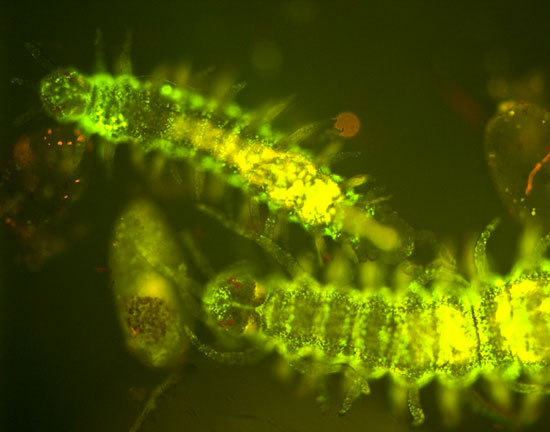New Clues to Sea's Green Glow

An eerie green glow that sometimes emanates from ocean waters was known to be produced by bioluminescent worms, but now scientists have uncovered some key clues as to just how the creatures produce their light show. The show isn't for us. Marine fireworms use bioluminescence to attract suitors in an undersea mating ritual. New research conducted by Scripps Institution of Oceanography marine biologists Dimitri Deheyn and Michael Latz reveals that the worms also may use the light as a defensive measure. The finding, detailed in the winter 2009 issue of the journal Invertebrate Biology, moves scientists closer to identifying the molecular basis of the light. "This is another step toward understanding the biology of the bioluminescence in fireworms, and it also brings us closer to isolating the protein that produces the light," Deheyn said. "If we understand how it is possible to keep light so stable for such a long time, it would provide opportunities to use that protein or reaction in biomedical, bioengineering and other fields — the same way other proteins have been used." The fireworms used in the study (Odontosyllis phosphorea) are seafloor-dwelling animals that inhabit tropical and sub-tropical shallow coastal areas. During summer reproductive events known as "swarming," females secrete a luminous green mucus — which often draws the attention of human seafarers — before releasing gametes into the water. The bright glow attracts male fireworms, which also release gametes into the bright green cloud. The precisely timed bioluminescent displays have been tracked like clockwork in Southern California, the Caribbean and Japan, peaking one to two days before each quarter moon phase, 30 to 40 minutes after sunset and lasting approximately 20 to 30 minutes. Deheyn and Latz collected hundreds of specimens from San Diego's Mission Bay for their study, allowing them to not only examine live organisms but also produce the fireworms' luminous mucus for the first time in an experimental setting. Beyond its use as a mate attractor, juveniles were found to produce bioluminescence as flashes, leading to a determination that the light also may serve as a defensive mechanism, intended to distract predators. Deheyn and Latz found that the bioluminescence is active in temperatures as low as minus 20 degrees Celsius (minus 4 degrees Fahrenheit). Higher temperatures, however, caused the bioluminescence to decay rapidly. The light also proved resilient in settings of low oxygen levels. Based on these tests, the researchers think the chemical process responsible for the bioluminescence may involve a specific light-producing protein called a photoprotein. Further identification and isolation will be pursued in future studies. The study was supported by a grant from the Air Force Office of Scientific Research's Biomimetics, Biomaterials and Biointerfacial Sciences program.
- 10 Amazing Things You Didn't Know About Animals
- Mystery Ocean Glow Confirmed in Satellite Photos
- Is the Red Sea Really Red?
Sign up for the Live Science daily newsletter now
Get the world’s most fascinating discoveries delivered straight to your inbox.











